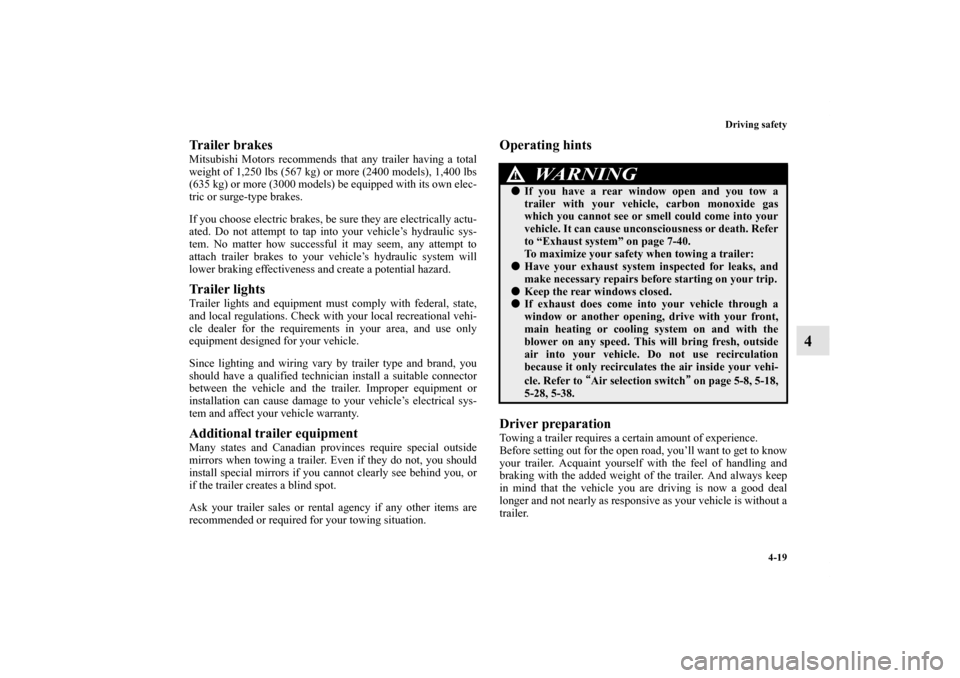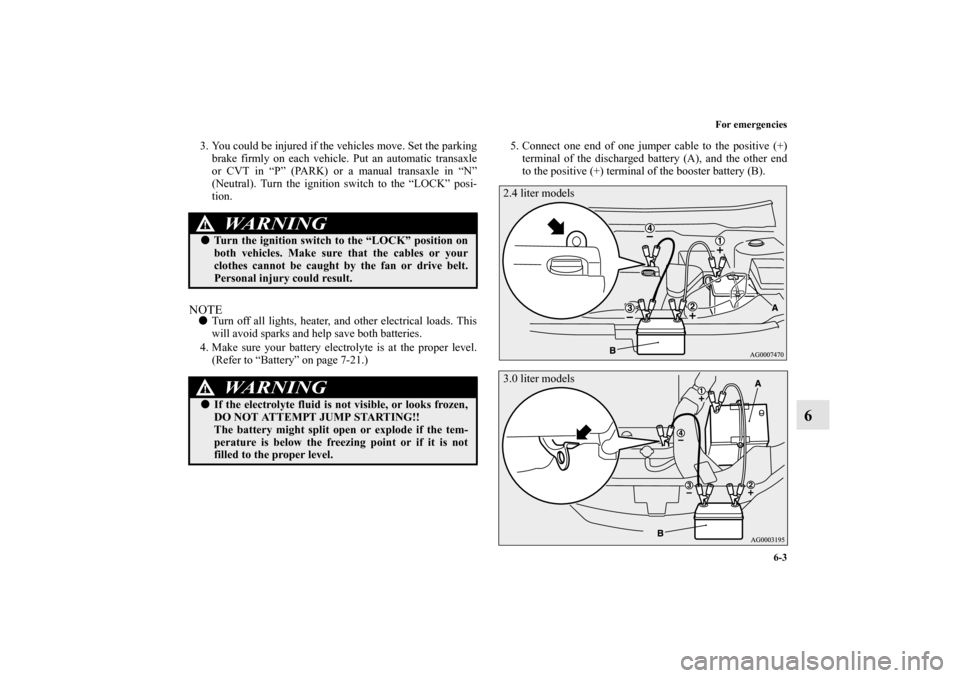Page 389 of 714
3-274 Features and controls
3
Lower glove compartmentThe lower glove compartment can be locked and unlocked
using the key.NOTE�In vehicles equipped with the F.A.S.T.-key, the glove
compartment can be locked and unlocked with the emer-
gency key.
Refer to “Emergency key” on page 3-34.
�When the lights are illuminated with the light switch in
the “ ”, “ ” or “AUTO” position (vehicles with auto-
matic light control), the glove compartment light illumi-
nates.Pen holder
There is a pen holder on the inside of the lower glove compart-
ment.
NOTE�There is a limit to the size of pen that fits. Forcing large
pens into the holder could cause damage.
1- To lock
2- To unlock
3- To open, pull the lever (A)
BK0122500US.book 274 ページ 2010年5月12日 水曜日 午前11時11分
Page 407 of 714

4-4 Driving safety
4
DefrostersCheck these by selecting the defroster mode, and set the blower
switch on high. You should be able to feel the air blowing
against the windshield.
Refer to “Defrosting or defogging (windshield, door win-
dows)” on page 5-14, 5-23, 5-33, 5-43.TiresCheck all the tires for heavy tread wear or uneven wear pat-
terns. Look for stones, nails, glass, or other objects stuck in the
tread. Look for any tread cuts or sidewall cracks. Check the
wheel nuts for tightness, and the tires (including spare tire) for
proper pressure. Replace your tires before they are heavily
worn out.
As your vehicle is equipped with a tire pressure monitoring
system, there is a risk of damage to the tire inflation pressure
sensors when the tire is replaced on the rim. Tire replacement
should, therefore, be performed only by an authorized Mitsub-
ishi Motors dealer.LightsHave someone watch while you turn all the exterior lights on
and off. Also check the turn signal indicators and high-beam
indicators on the instrument panel.Fluid leaksCheck the ground under the vehicle after parking overnight, for
fuel, water, oil, or other leaks. Make sure all the fluid levels are
correct. Also, if you can smell fuel, you need to find out why
immediately and have it fixed.
WA R N I N G
!�Always properly position floor mat and assure it
does not interfere with operation of the pedals.�Always use retaining clip on the driver’s floorboard
to secure the Mitsubishi genuine floor mat.�Always install the mat with the correct side facing
down.�Never install a second mat over an existing floor
mat.
BK0122500US.book 4 ページ 2010年5月12日 水曜日 午前11時11分
Page 408 of 714

Driving safety
4-5
4 Safe driving techniques
N00629200094
Even this vehicle’s safety equipment, and your safest driving,
cannot guarantee that you can avoid an accident or injury.
However, if you give extra attention to the following areas, you
can better protect yourself and your passengers:
�Drive defensively. Be aware of traffic, road and weather
conditions. Leave plenty of stopping distance between
your vehicle and the vehicle ahead.
�Before changing lanes, check your mirrors and use your
turn-signal light.
�While driving, watch the behavior of other drivers, bicy-
clists, and pedestrians.
�Always obey applicable laws and regulations. Be a polite
and alert driver. Always leave room for unexpected
events, such as sudden braking.
�If you plan to drive in another country, obey their vehicle
registration laws and make sure you will be able to get the
right fuel.
Driving during cold weather
N00629400373
�Check the battery. At the same time, check the terminals
and wiring. During extremely cold weather, the battery
will not be as strong. Also, the battery power level may
drop because more power is used for cold starting and
driving.
Before driving the vehicle, check to see if the engine runs
at the proper speed and if the headlights are as bright as
normally. Charge or replace the battery if necessary. Dur-
ing extreme cold weather, it is possible that a very low
battery could freeze.
�Warm the engine sufficiently. After starting the engine,
allow a short warm-up time to distribute oil to all cylin-
ders. Then drive your vehicle slowly.
Stay at low speeds at first so that the transaxle, transfer
case and rear axle oil have time to spread to all lubrication
points.
WA R N I N G
!�The battery gives off explosive hydrogen gas. Any
spark or flame can cause the battery to explode,
which could cause serious injury or death.
Always wear protective clothes and a face mask
when working with your battery, or let a skilled
mechanic do it.
BK0122500US.book 5 ページ 2010年5月12日 水曜日 午前11時11分
Page 422 of 714

Driving safety
4-19
4
Trailer brakesMitsubishi Motors recommends that any trailer having a total
weight of 1,250 lbs (567 kg) or more (2400 models), 1,400 lbs
(635 kg) or more (3000 models) be equipped with its own elec-
tric or surge-type brakes.
If you choose electric brakes, be sure they are electrically actu-
ated. Do not attempt to tap into your vehicle’s hydraulic sys-
tem. No matter how successful it may seem, any attempt to
attach trailer brakes to your vehicle’s hydraulic system will
lower braking effectiveness and create a potential hazard.Trailer lightsTrailer lights and equipment must comply with federal, state,
and local regulations. Check with your local recreational vehi-
cle dealer for the requirements in your area, and use only
equipment designed for your vehicle.
Since lighting and wiring vary by trailer type and brand, you
should have a qualified technician install a suitable connector
between the vehicle and the trailer. Improper equipment or
installation can cause damage to your vehicle’s electrical sys-
tem and affect your vehicle warranty.Additional trailer equipmentMany states and Canadian provinces require special outside
mirrors when towing a trailer. Even if they do not, you should
install special mirrors if you cannot clearly see behind you, or
if the trailer creates a blind spot.
Ask your trailer sales or rental agency if any other items are
recommended or required for your towing situation.
Operating hints
Driver preparationTowing a trailer requires a certain amount of experience.
Before setting out for the open road, you’ll want to get to know
your trailer. Acquaint yourself with the feel of handling and
braking with the added weight of the trailer. And always keep
in mind that the vehicle you are driving is now a good deal
longer and not nearly as responsive as your vehicle is without a
trailer.
WA R N I N G
!�If you have a rear window open and you tow a
trailer with your vehicle, carbon monoxide gas
which you cannot see or smell could come into your
vehicle. It can cause unconsciousness or death. Refer
to “Exhaust system” on page 7-40.
To maximize your safety when towing a trailer:�Have your exhaust system inspected for leaks, and
make necessary repairs before starting on your trip.�Keep the rear windows closed.�If exhaust does come into your vehicle through a
window or another opening, drive with your front,
main heating or cooling system on and with the
blower on any speed. This will bring fresh, outside
air into your vehicle. Do not use recirculation
because it only recirculates the air inside your vehi-
cle. Refer to “
““ “Air selection switch”
”” ” on page 5-8, 5-18,
5-28, 5-38.
BK0122500US.book 19 ページ 2010年5月12日 水曜日 午前11時11分
Page 571 of 714

6-2 For emergencies
6If the vehicle breaks down
N00836300158
If your vehicle breaks down on the road, move to the shoulder
and turn on the hazard warning flashers. If there is no shoulder,
or the shoulder is not safe, drive in the right lane slowly, with
the hazard lights flashing, until you come to a safe stopping
place. Keep the flashers flashing.If the engine stops/failsIf the engine stops, there will be no power assist to the steering
and brakes, making these difficult to use.
�The brake booster will not work, so the brakes will not
grip well. The brake pedal will be harder to press than
usual.
�Since there is no power steering assist, the steering wheel
will be hard to turn.When the engine fails at the intersectionGet help from your passengers, bystanders, etc. to push the
vehicle and move it to a safe zone.
Jump-starting the engine
N00836400524
If the engine cannot be started because the battery is weak or
dead, you can start it with the battery from another vehicle
using jumper cables.
1. Take off any metal jewelry such as watch bands or brace-
lets that might make an accidental electrical contact.
2. Position the vehicles close enough together so that the
jumper cables can reach, but be sure the vehicles aren’t
touching each other.
WA R N I N G
!�When using jumper cables to start a vehicle, follow
the procedures and be very cautious.
CAUTION
!�Do not try to start your vehicle by pushing or tow-
ing. Vehicles with automatic transaxles cannot be
started this way. Also, there is more risk of an acci-
dent when a vehicle is being pushed or towed.
CAUTION
!�Check the other vehicle. It must have a 12-volt bat-
tery. If the other system isn’t 12-volt, both systems
can be damaged.
BK0122500US.book 2 ページ 2010年5月12日 水曜日 午前11時11分
Page 572 of 714

For emergencies
6-3
6
3. You could be injured if the vehicles move. Set the parking
brake firmly on each vehicle. Put an automatic transaxle
or CVT in “P” (PARK) or a manual transaxle in “N”
(Neutral). Turn the ignition switch to the “LOCK” posi-
tion.NOTE�Turn off all lights, heater, and other electrical loads. This
will avoid sparks and help save both batteries.
4. Make sure your battery electrolyte is at the proper level.
(Refer to “Battery” on page 7-21.)5. Connect one end of one jumper cable to the positive (+)
terminal of the discharged battery (A), and the other end
to the positive (+) terminal of the booster battery (B).
WA R N I N G
!�Turn the ignition switch to the “LOCK” position on
both vehicles. Make sure that the cables or your
clothes cannot be caught by the fan or drive belt.
Personal injury could result.
WA R N I N G
!�If the electrolyte fluid is not visible, or looks frozen,
DO NOT ATTEMPT JUMP STARTING!!
The battery might split open or explode if the tem-
perature is below the freezing point or if it is not
filled to the proper level.
2.4 liter models3.0 liter models
BK0122500US.book 3 ページ 2010年5月12日 水曜日 午前11時11分
Page 642 of 714
Vehicle care and maintenance
7-45
7
Passenger compartment fuse location tablePassenger compartment fuse location
Sub fuse block Main fuse block
No.
Symbol
Electrical system
Capacity
1 Heater 30 A*
2Stop lights
(Brake lights)15 A
3 Rear fog light 10 A
4 Windshield wiper 30 A
5 Optional 10 A
6Door locks20 A
7Radio15 A
8 Control unit relay 7.5 A
9Interior lights
(Dome lights)15 A
10 Hazard warning flasher 15 A
11 Rear window wiper 15 A
12 Gauges 7.5 A
13Cigarette lighter
/Accessory socket15 A
14Ignition
Switch10 A
15 Sunroof 20 A
16 Outside rearview mirrors 10 A
17 All-wheel drive system 10 A
BK0122500US.book 45 ページ 2010年5月12日 水曜日 午前11時11分
Page 643 of 714
7-46 Vehicle care and maintenance
7
*: Fusible link
�Some fuses may not be installed on your vehicle, depend-
ing on the vehicle model or specifications.
�The table above shows the main equipment corresponding
to each fuse.
Engine compartment fuse location table
18 Back-up lights 7.5 A
19 Accessory socket 15 A
20 Power window control 30 A*
21 Defogger 30 A*
22 Heated door mirror 7.5 A
23 115V Power Outlet 15 A
24 Power seats 25 (20) A
25 Heated seats 30 ANo.
Symbol
Electrical system
Capacity
Engine compartment fuse location
Behind the fuse block cover
BK0122500US.book 46 ページ 2010年5月12日 水曜日 午前11時11分